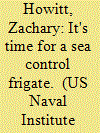|
|
|
Sort Order |
|
|
|
Items / Page
|
|
|
|
|
|
|
| Srl | Item |
| 1 |
ID:
137943


|
|
|
|
|
| Summary/Abstract |
In East Asia, the coercive use of maritime capabilities has led some to argue that the return of gunboat diplomacy has become inevitable. The use of coercion and deterrence there are indeed undeniable. However, Alessio Patalano argues that there is more than gunboats to diplomacy in a self-aware maritime East Asia. Capable navies can offer a significant contribution when dealing with major natural disasters, and these deployments should be regarded as diplomatic missions aimed at building relations and enhancing regional security. Japan's experience in this regard provides a relevant case in support of this argument.
|
|
|
|
|
|
|
|
|
|
|
|
|
|
|
|
| 2 |
ID:
130066


|
|
|
|
|
| Publication |
2014.
|
| Summary/Abstract |
A vessel based on the national security cutter could offer significant benefits to the Navy.
W hile O liver Hazard Perry- class frigates are not the only platforms you would want for a serious confrontation, they are great independent-deployers and effective at a multitude of missions such as escort operations and antisubmarine warfare (ASW). As the Navy decommissions the last 15 frigates, soon to be joined by 21 Ticonderoga- class cruisers, we will call on our existing hulls to support their ongoing missions. There is little doubt the littoral combat ship (LCS) fills some of this void, but even the top brass seem to agree that it's ineffective in a high-endurance, blue-water setting.
In January, a report from the Pentagon described a plan to cut the amount of LCSs from 52 to 32 ships, and in a leaked classified memo, Commander of Naval Surface Forces Vice Admiral Tom Copeman called for a new type of multi-mission ship. 1 Many envision a new combatant ship that incorporates air- and missile- defense radar and an electromagnetic railgun. While it is imperative that the Navy build these types of ships, a multibillion-dollar warship juggernaut is simply unnecessary when a new, cost-effective frigate could effectively accomplish the same missions.
Of the many potential frigate designs, Huntington Ingalls Industries offers one derived from its successful national security cutter (NSC) hull dubbed the "patrol frigate," originally intended and modeled for international navies. At first, it may seem preposterous to paint a Coast Guard cutter gray and call it a warship. In the July 2013 issue of Proceedings , Norman Polar opined that more frigates were needed, but was quick to dismiss a patrol frigate as a viable option. He claimed it "lacked growth potential and service life, as well as certain military features." 2 But tweaking the NSC could turn it into a viable candidate that meets the Navy's needs.
|
|
|
|
|
|
|
|
|
|
|
|
|
|
|
|
| 3 |
ID:
130065


|
|
|
|
|
| Publication |
2014.
|
| Summary/Abstract |
China is deploying an ocean-floor surveillance network to strengthen its antisubmarine-warfare capability.
As China's naval modernization program has shifted into high gear in recent years, numerous defense analysts, both inside and outside China, have rightly pointed to the People's Liberation Army Navy's (PLAN's) quite obvious weaknesses in antisubmarine warfare (ASW) as a persistent Achilles' heel of the evolving force. Although the 2012 introduction of the Type 056 light frigate, which has subsequently been produced at an unusually rapid clip, may represent a significant step toward increasing ASW prowess, there appears to be a long road ahead for Chinese development in this realm. This is made more likely given the profound paucity of operational experience in the PLAN, as well as the apparently long-time neglect of maritime-patrol aircraft and ship-borne helicopters.
|
|
|
|
|
|
|
|
|
|
|
|
|
|
|
|
|
|
|
|
|